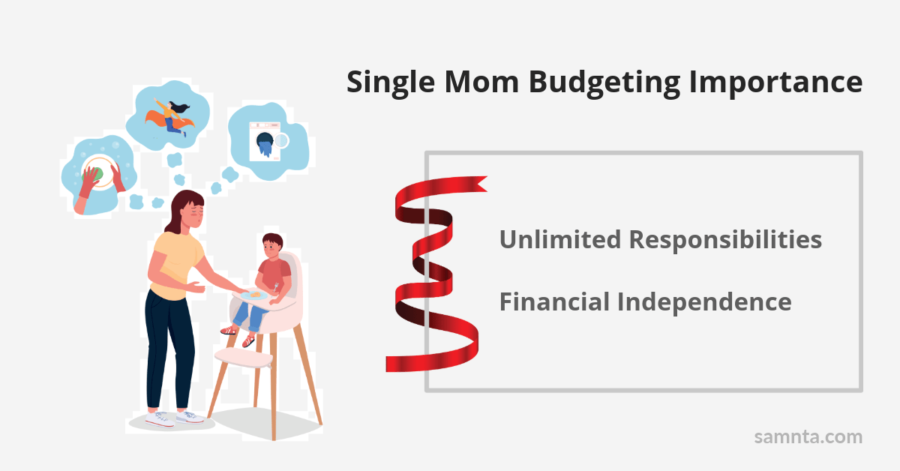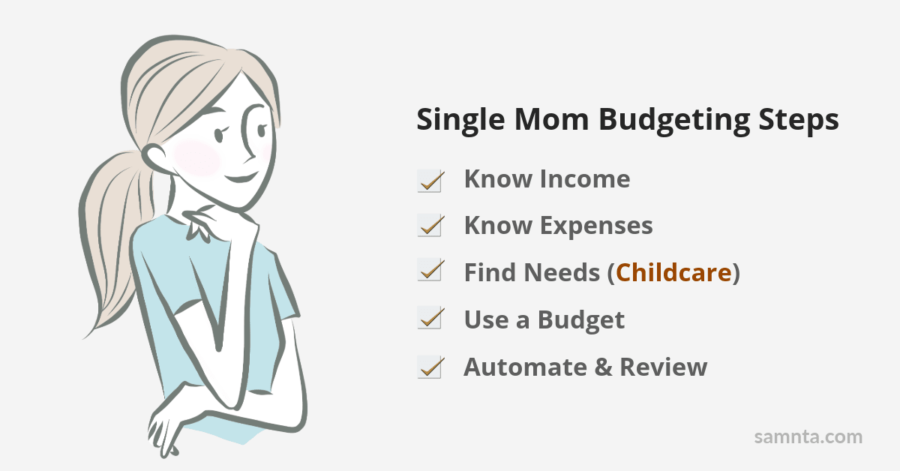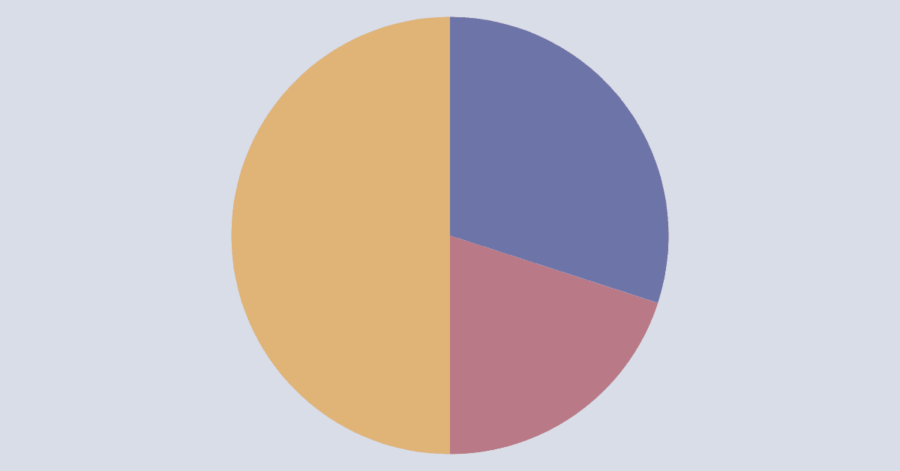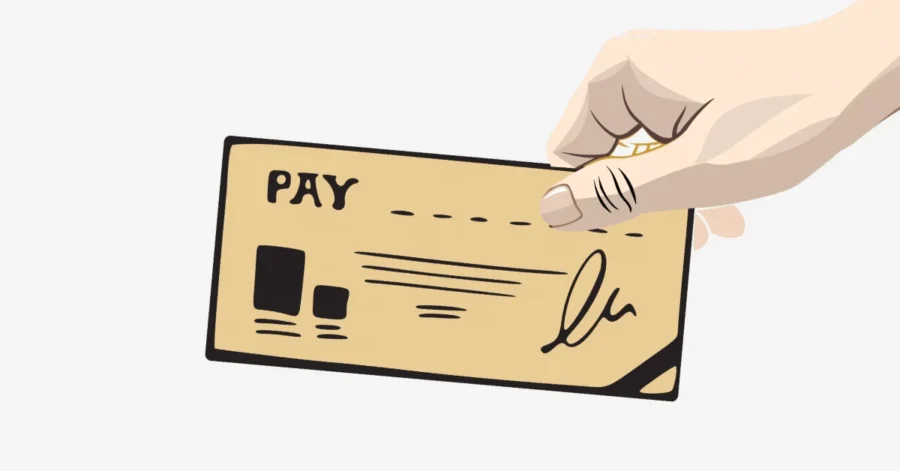Being a single mom comes with a lot of challenges, with financial management often coming first. You’re juggling everything on your own, including earning a salary, taking care of your kids, and managing the household.
It can feel overwhelming, especially when money is tight and unexpected expenses pop up.
But a personalized budget, especially for a single mom, can help you build a financial foundation and reduce stress.
What You’ll Learn
ToggleWhy Budgeting Matters for Single Moms

When you are parenting children on your own, every financial decision becomes more important. You’re the sole provider and the role model.
This is why budgeting is not only beneficial but also necessary. To understand better, consider these three points:
1. Unlimited Responsibilities
Most single mothers depend on one income, and the crazy thing is that income is not consistent. Without a second earner to fall back on, it is difficult to make financial decisions.
In this situation, a budget allows you to maximize the use of your money while covering essential expenses, such as housing, groceries, and childcare.
2. Financial Independence
Single moms rely on others for financial help, whether it’s family, friends, or government assistance.
As a result, budgeting helps you achieve independence gradually by providing you with control over your spending and savings.
3. Reduce Financial Stress
Financial stress can have a negative impact on your mental and emotional health. When you’re continually concerned about bills or unexpected expenses, it’s difficult to concentrate on anything else.
A detailed budget provides a road map, letting you know what’s coming and where your money is going. That peace of mind is invaluable.
As a single mom, taking control of your finances is one of the most important actions you can do for your family’s future.
Steps to Budgeting as a Single Mom

Step 1: Assess Your Income
Before creating a budget, you need to know exactly how much you earn each month, including all sources of income, such as your paycheck and freelancing.
Use your net income to create a budget. Consider keeping track of the monthly earnings with a spreadsheet, notebook, or budgeting app
Once you know your income, you are ready to begin tracking what you spend.
Step 2: Know Your Expenses
The next step is to determine where the money is going. Many single moms are surprised to see how quickly small purchases add up or how certain bills shift month to month.
Tracking your expenses gives you a full picture and helps you take back control.
Break Expenses into Two Categories:
1. Fixed Expenses
These are the same costs that don’t change from month to month or are necessary for the stability of your household.
- Rent or mortgage
- Utilities (gas, water, and electricity)
- School fees or childcare
- Insurance
- Transportation (car payment, public transportation)
- Payments for loans
- Internet and phone
2. Variable Expenses
These can change month to month and are often where you have more room to adjust.
- Food and Groceries
- Clothes for you or the kids
- Diapers, wipes, and other baby needs
- Entertainment and eating out
- Household supplies
- Gifts and special occasions
- Medical costs and prescriptions
It is very easy to track each and every expense by reviewing your bank statements from the last 1–3 months and saving receipts for a month. After that, categorize them with the help of a notebook or a spreadsheet.
Step 3: Prioritize Your Needs
You are now aware of what you are earning and spending. It’s time to set priorities as a single mother and concentrate on what matters most to you and your kids.
Start with the Essentials that should always be the basics that keep your home safe and your family functioning:
- Housing (rent/mortgage)
- Utilities (electricity, water, heat)
- Food and groceries
- Childcare and school-related needs
- Transportation (gas, car payments, bus fare)
It is necessary to address these before proceeding.
Try to set aside money for savings, such as an emergency fund, sinking funds for additional expenses, and debt repayments, even if your budget is tight.
Step 4: Use a Budgeting Method
When it comes to budgeting, there is no one-size-fits-all solution. The ideal approach is the one that works for you, fits into your schedule, and is simple to follow through on, even during difficult times.
Flexibility and simplicity are essential for single mothers. Here are a few popular budgeting methods that work well for single moms:
1. 50/30/20 Rule
Best for: Moms with steady income who want a balanced, flexible system.
Working: this rule divides the earnings in 50% Needs (rent, food, utilities, childcare), 30% Wants (dining out, entertainment, extras), 20% Savings and Debt (emergency fund, paying down credit cards, etc.)
2. Zero-Based Budget (ZBB)
Best for: Moms who want to maximize every dollar and stay ultra-organized.
Working: Income – Expenses = $0 (every month starts from zero)
3. Cash Envelope System
Best for: Moms who tend to overspend or need a visual way to stay on track.
Working: arrange spending categories into envelopes, such as food, entertainment, and childcare.
4. Pay-Yourself-First
Best for: Moms who want to build savings without overthinking it.
Working: Every month, set aside a certain amount for savings before making any other spending decisions.
5. Kakeibo
Best for: Moms who want a mindful, intentional approach and don’t mind journaling or writing things by hand.
Working: An approach based on writing that encourages you to take your time and think about how you spend your money.
Step 5: Automate and Review
The more you integrate budgeting into your daily practice, the more effective it becomes. As a busy single Mom, two major tasks to do:
Automate
Automating the management of money reduces emotion and decision fatigue. Little actions can have a significant impact.
To save money and prevent late fees, set up autopay for your payments. For automation, consider calendar reminders and apps..
Review
Life changes fast, especially with kids. For this reason, it’s critical to review your budget on a regular or weekly basis.
You don’t have to be obsessed with reviewing the budget; it just means observing where you spend your money.
Conclusion
Budget as a single mom isn’t easy, but it is absolutely possible. With the right mindset and a plan tailored to your life, you can take control of your finances, reduce stress, and create more stability for your family.
Remember, consistency is more important than perfection when creating a budget. By sticking to even a basic budget, you can ensure a bright future for yourself and your children.
FAQs
How can a Single Mom Start Budgeting?
Start by tracking your income and essential expenses. Choose a simple approach, such as zero-based budgeting or the 50/30/20 rule.
What is the best Budgeting Method for Single Moms?
The best method is one that fits your lifestyle. Try 50/30/20, zero-based budgeting, or Kakeibo for a more mindful approach.
Why is Budgeting Important for Single Moms?
For single moms, budgeting is important because it helps them manage their limited income, pay for essentials, and feel less stressed about money.






